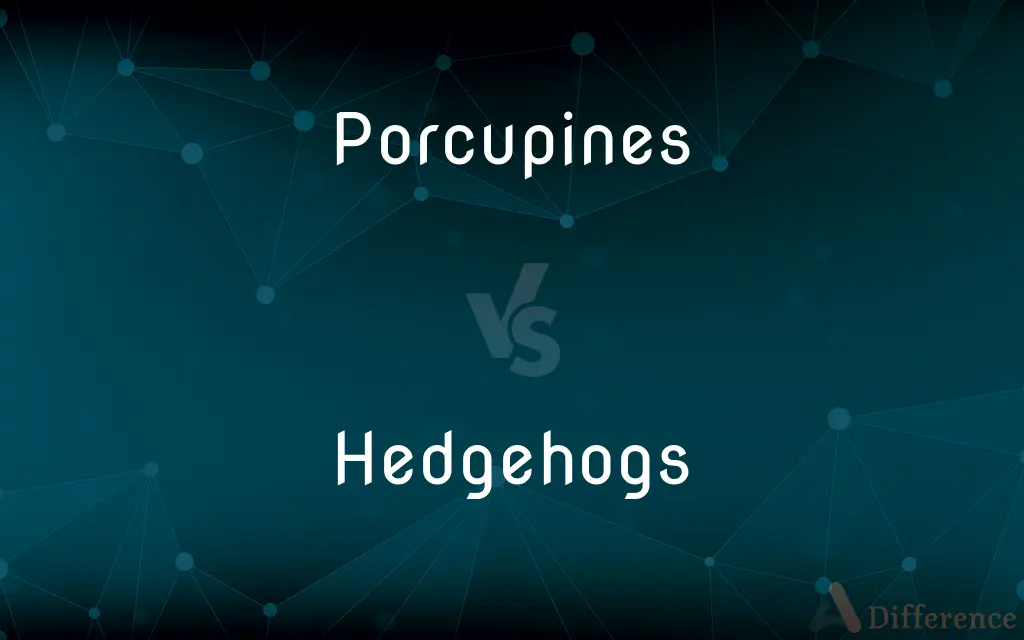Porcupines vs. Hedgehogs — What's the Difference?
By Tayyaba Rehman — Published on December 20, 2023
Porcupines are large, nocturnal rodents with long quills, native to Americas and Asia, while Hedgehogs are small, spiny mammals found mainly in Europe, Asia, and Africa.

Difference Between Porcupines and Hedgehogs
Table of Contents
ADVERTISEMENT
Key Differences
Porcupines are typically larger rodents with long quills that can detach when threatened. In contrast, Hedgehogs are smaller mammals with spines that are short and remain attached to their bodies.
Geographically, Porcupines are native to the Americas and parts of Asia, living primarily in trees or on the ground depending on the species. Hedgehogs, however, are primarily ground dwellers found in Europe, Asia, and Africa.
Behaviorally, Porcupines are mostly nocturnal and rely on their sharp quills for defense, releasing them when threatened. Hedgehogs, on the other hand, curl into a ball when in danger, presenting their spines outward.
In terms of diet, Porcupines are primarily herbivores, feasting on plants, bark, and sometimes small creatures. Hedgehogs, while also primarily insectivores, have a diverse diet that includes insects, snails, frogs, and even small vertebrates.
Reproduction differs as well; Porcupines have a longer gestation period and usually give birth to one offspring at a time. Hedgehogs tend to have shorter gestation periods and can birth several hoglets in a litter.
ADVERTISEMENT
Comparison Chart
Size
Larger
Smaller
Geographic Distribution
Americas and parts of Asia
Europe, Asia, and Africa
Defensive Mechanism
Release quills when threatened
Curl into a ball exposing spines
Diet
Primarily herbivorous
Insectivores with varied diet
Reproduction
Longer gestation, usually one offspring
Shorter gestation, several hoglets
Compare with Definitions
Porcupines
Nocturnal animals native to the Americas and Asia with detachable spines for defense.
When threatened, Porcupines can release their quills as a defensive mechanism.
Hedgehogs
Creatures found primarily in Europe, Asia, and Africa with a coat of sharp spines.
Hedgehogs are often seen rummaging in gardens at night.
Porcupines
Large rodents known for their long, sharp quills.
The Porcupines climbed the tree effortlessly, its quills shimmering in the sunlight.
Hedgehogs
Small, spiny mammals known to curl into a defensive ball.
The Hedgehogs curled up when the curious dog approached.
Porcupines
Herbivorous creatures that primarily feed on plants and bark.
The gardener was frustrated by the Porcupines nibbling on his plants.
Hedgehogs
Animals with a unique protective mechanism of presenting spines when threatened.
The spines of Hedgehogs are not detachable like those of Porcupines.
Porcupines
Animals with a unique defense mechanism of detaching quills upon contact.
It's a myth that Porcupines can shoot their quills; they only release upon touch.
Hedgehogs
Ground dwellers known for their characteristic appearance and behavior.
Children's books often feature Hedgehogs as cute, spiny protagonists.
Porcupines
Mammals with a distinct appearance due to their covering of long quills.
The children were fascinated by the Porcupines' unique appearance at the zoo.
Hedgehogs
Any of several small insectivorous mammals of the subfamily Erinaceinae, native to Eurasia and Africa and naturalized in New Zealand, having dense erectile spines covering the back and sides and characteristically rolling into a ball for protection.
Porcupines
Any of various rodents of the family Hystricidae, of Eurasia and Africa, or the family Erethizontidae, of the Americas, having long, sharp, erectile quills.
Hedgehogs
Any of several spiny animals, such as the porcupine, that are similar to the hedgehog.
Porcupines
Plural of porcupine
Hedgehogs
A well fortified military position.
Porcupines
Meat patties rolled in rice and simmered in a tomato sauce
Hedgehogs
An antisubmarine weapon consisting of several rows of mortar-like dischargers positioned to fire in a circular pattern ahead of a ship.
Hedgehogs
An obstacle used against tanks and landing craft, consisting of three crossed iron bars welded or bolted together.
Hedgehogs
Plural of hedgehog
Hedgehogs
Infl of hedgehog
Hedgehogs
Primarily insectivorous mammals that have a varied diet.
The diet of Hedgehogs includes insects, snails, and sometimes small frogs.
Common Curiosities
Which is larger, Porcupines or Hedgehogs?
Porcupines are typically larger than Hedgehogs.
Are Porcupines and Hedgehogs related species?
While both are mammals, Porcupines are rodents and Hedgehogs belong to the Erinaceidae family.
Where can you commonly find Porcupines in the wild?
Porcupines are native to the Americas and parts of Asia.
What do Hedgehogs primarily feed on?
Hedgehogs are primarily insectivores but have a varied diet.
Do Porcupines climb trees?
Yes, some species of Porcupines are arboreal and live in trees.
Which has a more varied diet, Porcupines or Hedgehogs?
While both have varied diets, Hedgehogs, being insectivores, might have a slightly more diverse diet.
Can both Porcupines and Hedgehogs release their spines?
Only Porcupines can release their quills; Hedgehogs' spines remain attached.
How do Hedgehogs defend themselves?
Hedgehogs curl into a ball, presenting their spines outward.
How long do Hedgehogs live?
In the wild, Hedgehogs live for around 2-5 years, but in captivity, they can live longer.
Is it true Porcupines can shoot their quills?
No, this is a myth. Porcupines release quills upon contact but don't "shoot" them.
Can you keep Hedgehogs as pets?
In some countries, yes, but it's essential to research and ensure their specific needs are met.
How do Porcupines communicate?
Porcupines use vocalizations, quill rattling, and body language.
Which is more common as a pet, Porcupines or Hedgehogs?
Hedgehogs are more commonly kept as pets in certain countries.
How do Porcupines protect their young?
Porcupine young, or porcupettes, are born with soft quills that harden over time, offering protection.
Are the spines of Hedgehogs poisonous?
No, Hedgehogs' spines are not poisonous.
Share Your Discovery

Previous Comparison
Teacher Training vs. Teacher Education
Next Comparison
Mom Jeans vs. Skinny JeansAuthor Spotlight
Written by
Tayyaba RehmanTayyaba Rehman is a distinguished writer, currently serving as a primary contributor to askdifference.com. As a researcher in semantics and etymology, Tayyaba's passion for the complexity of languages and their distinctions has found a perfect home on the platform. Tayyaba delves into the intricacies of language, distinguishing between commonly confused words and phrases, thereby providing clarity for readers worldwide.
















































